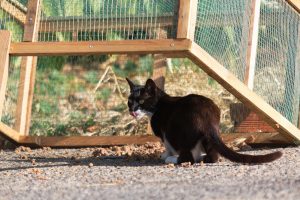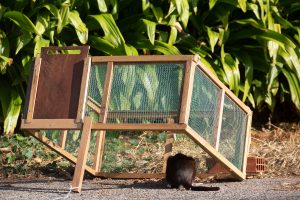TNR: Getting started
You can see how much careful consideration and thought is required before you even begin! Now the planning for a successful TNR programme starts.
Equipment
- You need good equipment from established manufacturers and you must be able to use it correctly
- Make a list of the equipment you need and your plans to obtain it, identify and track it, maintain and store it
- Your equipment will need to be kept clean to avoid infection and cleaning/disinfection products must be suitable for use around cats
- Everyone using the equipment will need to be trained and it may be wise to have one or two experts who can train others. Wrong use of equipment may cause harm to cats. See this list:
Equipment checklist:
|
Traps
There are different types of trap. There are automatic traps and traps which are triggered manually. They come in standard sizes for cats, along with larger and smaller ones for other species. Sometimes a small animal trap is useful to trap kittens that may not weigh enough to trigger an adult trap. Manual traps also include larger sizes for trapping groups of cats.
Automatic Traps
- These traps can be left unattended and rely on the cat triggering a mechanism (usually a pedal) when they go in for food
- These are good for trapping individual cats, and those that will only come out when no one is around
- They are useful if you are unable to remain on-site for long periods and also if you have a volunteer who is able to alert you or transport the trap to the vet
- Traps should be checked regularly (you could use webcams in WiFi-enabled areas) on enclosed or access-controlled property
- On publicly accessible space automatic traps should be supervised at all times. If you are leaving any trap unsupervised it is good practice to leave notices advising people why they are there and to reassure them that this is positive for the cats
- Traps should be covered to increase the sense of security for the cats
- You may catch cats or other animals that you have not targeted
- Some kittens may be too small to trigger the mechanism
- Some cats may also manage to eat the food by avoiding the mechanism
- In some cases, seeing cats in the traps will frighten away other members of the colony making them more difficult to trap
- Any automatic trap can be converted to manual by propping open the door with an object such as a full bottle of water with string attached. The bottle is pulled away to spring the trap rather than the pedal triggering the trap.
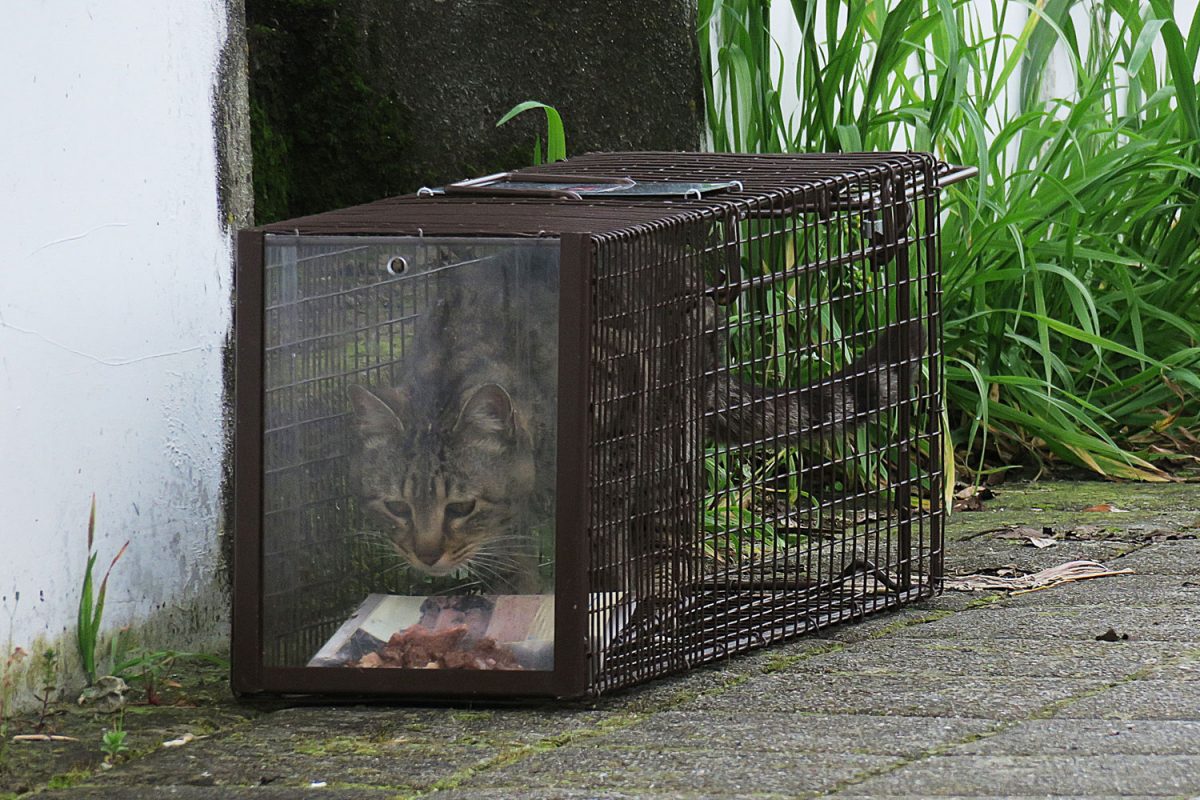
The MDC eezicatch cat trap has a sliding panel of transparent acrylic that gives the cat the illusion of having an escape route if it is reluctant to enter
Manual traps
- These traps rely on someone being close to the trap to trigger the mechanism at the right time
- These traps give greater control of which cats are trapped (eg if only trapping females) and catching pets or previously neutered cats can be avoided
- More than one cat at a time (especially litters of kittens)
- These traps may also reduce the level of anxiety in the group as the traps are triggered less often
- The traps can be closed by a range of techniques – sticks, string, electronic fobs etc.
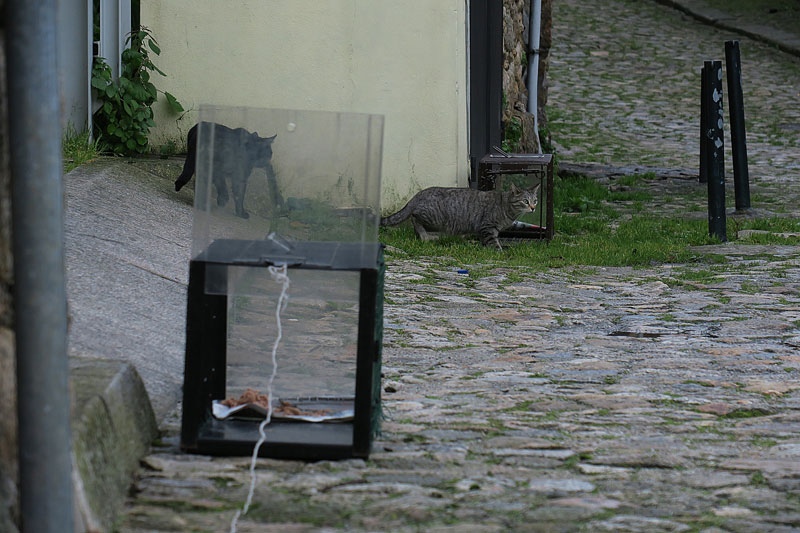
This is a manual trap that is closed by someone from a distance using a length of string
Drop traps
- A drop trap can be suspended and dropped from above over a cat
- The cat does not have to enter a tight space where it may feel confined. Many cats that avoid entering a normal trap will enter this one
| Sofia Róis from Animais de Rua in Portugal offers this tip when using drop traps:
“We use a bottle, full of sand, or something similar, so when a drop trap is activated, cats cannot move it. In this case we used a brick, but the effect is the same, something that holds the trap and gives it stability.”
|
Trap transfer cages
Trap transfer cages have sliding doors that allow them to be placed against a matching sliding door on the trap for safe and easy transfer. It is best to have cages and traps that are designed to work together for ease of use. Transfer to top opening cat carriers or carriers with hinged doors can be very difficult in the field and may result in cats escaping.
Cats can be anaesthetised in the transfer cage (if it has a restraint facility also known as a crush or squeeze cage), or in the trap/other carrier using appropriate handling equipment.
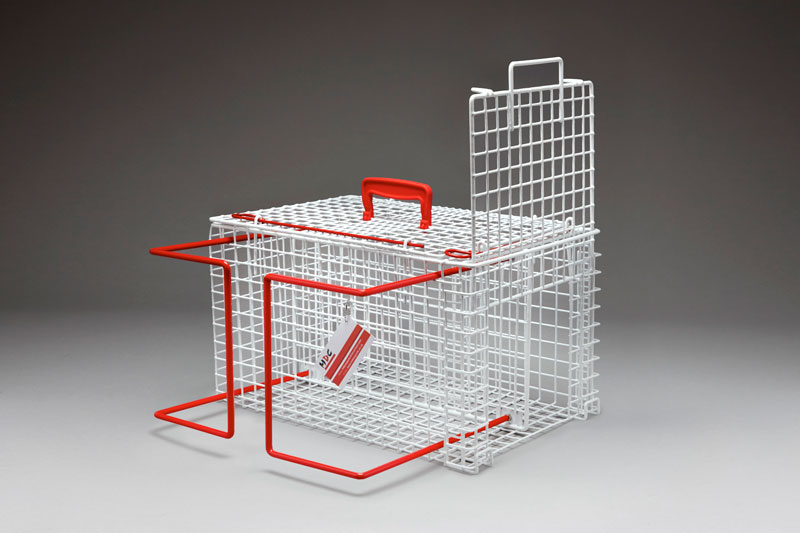
A trap transfer cage (source MDC)
Personal safety
People undertaking TNR work will find themselves in a range of environments – domestic homes, abandoned buildings, city centres, hotels, tourist sites, factories, parks and open countryside. All will have different hazards that need to be assessed and taken into account.
Frightened cats that are not used to being handled can inflict dangerous wounds. Direct handling must be avoided at all times by using the right equipment – traps, transfer cages and carriers (with a restraint facility) and protective gloves. Never assume that a cat that you can touch while it is eating can be picked up and put in a carrier.
- Be aware of the surroundings, especially in unfamiliar places and when trapping at night
- Seek local knowledge for advice or ask locals to be around when trapping
- Check the mobile phone coverage in case of an emergency
- Ideally, you should always trap with at least one other person. This means that one can watch over the cats while the other is putting cats in the vehicle. It also makes transfer to a carrier much easier. Most importantly they can help in the case of any problems which arise
- Make sure you are wearing appropriate clothing and suitable footwear depending on the environment and weather conditions
- Have an emergency protocol so that you always know where fellow trappers are going and when
- Make sure everyone has fully charged mobiles (keep spare chargers in vehicles) and set up a code that enables you to ask for help discreetly. For example, you may have a pre-programmed text that you can send asking for help, or you may agree to call other trappers at certain times to check that everything is okay and have a phrase that means help is needed. In some cases, asking people to call in when they are safely home is a good idea
- There may be times when you have to deal with difficult situations where emotions run high and people can become upset, angry or aggressive. You may want to consider training in managing/defusing these situations so that they don’t escalate and people know when to back away
- Make sure that everyone has had the appropriate vaccinations to protect them if they are bitten eg, tetanus and rabies (if relevant). A protocol for what to do if someone is bitten is essential, although the best thing to do is to prevent cat bites
- Make sure that everyone uses protection for other problems, such as mosquitoes. It is important to remember that in areas where rabies is prevalent a bite from a cat to a person can result in that animal being euthanised
- Be aware of other diseases that can be transferred from cats to people (zoonotic diseases)
- If doing lots of trapping, employing staff or working in potentially dangerous areas, a service such as Skyguard (in the UK) which provides cellphone/GPS linked panic alarms may be worth considering
- Make friends with local police, community support officers, municipality or community police etc
| Covid-19 Advice
Advice for those undertaking TNR and/or feeding unowned cat colonies during the coronavirus crisis |




